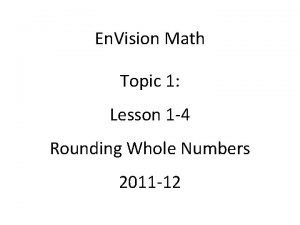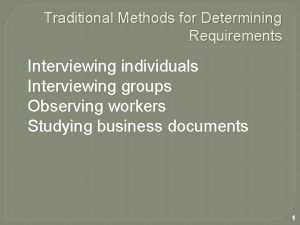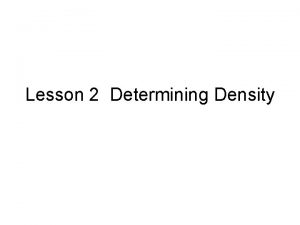Passing Topic 3 Lesson 1 Determining Passing TimeSpace









- Slides: 9

Passing!

Topic 3 Lesson 1 Determining Passing Time/Space Needs To pass another vehicle safely you must: • identify a safe and legal passing zone; • judge the time and space needed to pass; • judge the relative speed and distance of other vehicles; and • apply proper passing skills and complete the maneuver safely. T – 5. 23

Topic 3 Lesson 1 Determining Passing Time/Space Needs Identifying a Safe and Legal Passing Zone Before you pass, you must determine: 1. if you are in a legal passing zone • broken line = pass with caution • solid line = no passing • list other areas where passing is prohibited 2. the time you will need to pass safely 3. the space you will need to safely pass the other vehicle TRAVEL TIME = SPACE v. Formula – Speed + ½ speed = feet per second (fps) traveled v 60 mph -- 60 + 30 = 90 fps T – 5. 23 a

Topic 3 Lesson 1 Determining Passing Time/Space Needs Judging the Relative Speed and Distance of Other Vehicles To estimate the time and distance of an oncoming vehicle, begin counting when the vehicle is first seen: 1000 and 1; 1000 and 2; etc. Continue the count until the approaching vehicle is opposite your vehicle. Practicing this technique will help you develop the ability to judge speed and distance. 1000 and 20 1000 and 2 1000 and 1 COUNT --- 1000 and 1 = 1 second T – 5. 24 a

Topic 3 Lesson 1 Passing Time/Space Needs — Oncoming Vehicles Judging the Relative Speed and Distance of Oncoming Vehicles The example below is based on the approaching vehicle traveling at 40 mph. ØRed vehicle will need 780 feet to complete the pass ØBrown vehicle will travel 780 feet ØAllows a minimum 200 ft. space cushion To complete a pass safely you must take ALL factors into account Space Cushion 13 seconds / 780 ft. 200 ft 13 seconds / 780 ft. TOTAL distance required to pass safely is 1760 ft (30 seconds). T – 5. 24 b

Topic 3 Lesson 1 Passing Considerations — Larger Vehicles Passing a 90 -foot tractor trailer • Would require an additional 5 seconds for the Red vehicle 90 -foot truck + 15 -foot car = 75 feet additional distance traveled = 5 seconds • 18 seconds x 60 fps = 1080 feet needed by Red vehicle Daylight Headlight Use Enhances Safety • an approaching vehicle without headlights becomes visible at about 2, 200 to 2, 500 feet • an approaching vehicle with headlights becomes visible at distances up to 4500 feet Passing on Multi-lane Roadways • safer than on two lane roadways • head-on crashes are rare • will not feel rushed into returning If there is an oncoming vehicle traveling 40 mph, the total clear distance needed to pass safely becomes 1360 feet (23 seconds) 1080 + 200 (space cushion) to the lane • can safely pass larger vehicles that require more time and space to pass T – 5. 25

Topic 3 Lesson 1 Passing Procedures 2 – 3 Seconds Prepare to Pass: • Position vehicle two to three seconds behind the vehicle to be passed. • Check mirrors, blind spot and oncoming traffic. • Check ahead for safe passing distance. Overtake the Ongoing Vehicle: • Accelerate into passing lane. • Accelerate quickly to a legal appropriate speed. • Monitor the path ahead. • Check the mirror following vehicles. Return to Lane: • Check rear-view mirror for the front of the vehicle being passed. • Signal intention. • Change lanes and maintain speed. • Cancel turn signal. • Signal intention. T – 5. 26

Topic 3 Lesson 1 Virginia Law § 46. 2 -838 — Passing when overtaking a vehicle The driver of any vehicle overtaking another vehicle proceeding in the same direction shall pass at least two feet to the left of the overtaken vehicle and shall not again drive to the right side of the highway until safely clear of such overtaken vehicle. § 46. 2 -839 — Passing bicycle or moped In approaching or passing a person riding a bicycle or moped, the driver of a motor vehicle shall pass at a safe distance and at a reasonable speed. § 46. 2 -841 — When overtaking vehicle may pass on right A. The driver of a vehicle may overtake and pass to the right of another vehicle only: 1. When the overtaken vehicle is making or about to make a left turn, and its driver has given the required signal 2. On a highway with unobstructed pavement, not occupied by parked vehicles, of sufficient width for two or more lines of moving vehicles in each direction; or 3. On a one-way street or on any one-way roadway when the roadway is free from obstructions and of sufficient width for two or more lines of moving vehicles. B. The driver of a vehicle may overtake and pass another vehicle on the right only under conditions permitting such movement in safety. Except where driving on paved shoulders is permitted by lawfully placed signs, no such movement shall be made by driving on the shoulder of the highway or off the pavement or main traveled portion of the roadway § 46. 2 -842 — Driver to give way to overtaking vehicle Except when overtaking and passing on the right is permitted, the driver of an overtaken vehicle shall give way to the right in favor of the overtaking vehicle on audible signal and shall not increase the speed of his vehicle until completely passed by the overtaking vehicle. Any over-width, or slow-moving vehicle shall be removed from the roadway at the nearest suitable location when necessary to allow traffic to pass. T – 5. 27

SMOG • Signal • Mirror check (center) • Over the shoulder check • GO!! (don’t hesitate)

















